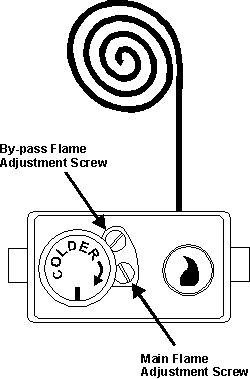Dave's Place
Other Gas Thermostats

Over the years a multitude of gas thermostats have come along. Some were big and bulky, and quickly obsolete, while others took on the safety valve responsibilities as well as their own thermostat functions. The Baso and Junkers gas valves are examples of these and were popular in RV refrigerators in the 70's. They're both obsolete now, but conversion kits are available for some refrigerator models. Another valve, the Sourdillon Control, also took on these functions but added to them. It's still in use today.
Although all gas thermostats do essentially the same thing, control the size of the burner flame depending on the temperature of the box, there were various ways of accomplishing this. Many used (and still use) the by-pass screw to set the low flame, or by-pass flame. Some were preset and had no adjustment. And, others had an adjustment screw for the by-pass flame.
The Junkers gas valve, below, is a good example of an older gas control. It incorporated the gas thermostat and safety valve into one component and had an adjustment screw for the by-pass flame.
Probably the first thing you need to know about thermostats with adjustment screws, is don't mess with them. They were pre-set at the factory, and if they have been set correctly for the last however many years of operation, why would they suddenly be set incorrectly? Unless, of course, somebody's messed with them. If you have a gas problem, look elsewhere first. See Gas Diagnosis for more information.
If you have to make adjustments to the thermostat, understand and know what you're trying to accomplish before you start. A problem with the by-pass flame will either be the flame dropping out (too low) or continuing to cool when in by-pass mode (too high). There's really no need for the main burner adjustment. The thermostat is supposed to let full pressure through when cooling is called for. Just be sure the screw is backed off far enough not to restrict gas flow.
Making Adjustments
First of all, get the refrigerator down to operating temperature (38 to 40 degrees Fahrenheit) in the lower box.
This is necessary so you can see when the thermostat goes to and from low flame. See Gas Thermostat
for more information about the by-pass flame. At operating temperature, the transition to low flame should occur
about half way through the knob rotation. If it doesn't, you can remove the plastic knob and rotate it
independently of the thermostat shaft to adjust the temperature range, the points on the knob where the
thermostat goes to by-pass mode at certain temperatures. If you can't reach this point on the thermostat,
it may be bad. Note, however, if someone has severely tampered with the adjustment screws, you may not be
able to recognize the change to low flame. If this is the case, you will want to turn the by-pass screw
all the way in (clockwise) and then back out a turn or two to get a tentative low flame. A stop built into
the knob keeps the user within a meaningful temperature range, but the shaft on some gas thermostats can
rotate completely two or three times for adjustment. Many other thermostats have the stop built into the
thermostat and cannot be adjusted in this way.
Once you have the thermostat going to by-pass mode when you want it to, you want the low flame to act properly. To act properly, the low flame needs to be high enough so that it is not the cause for the safety device shutting off the flow of propane, while at the same time being low enough so that it doesn't cause the refrigerator to continue to cool. If you have a manometer and a test point, a good starting pressure for the by-pass flame is 1 1/2" WC. The Junkers thermostat has a test point on it, but any test point after the thermostat will do. Generally a by-pass flame should not go above 3" WC. To decrease the pressure and therefore the flame, turn the screw in (clockwise).
The next step is patience. Wait and see how the refrigerator operates; this could take 24 hours for a thorough test. Then, adjust accordingly. If you can't seem to reach a point where the flame doesn't drop out and also cooling ceases, you might want to suspect a weak thermocouple.RV Refrigerator Home
This RV refridgerator information was originally located on rvmobile.comRV Mobile Inc. 11715 HWY 99, Everett, WA 98204
The owner of RV Mobile Inc. apparently suffered a heart attack and the original website was shut down.
It has been reposted here to preserve this wealth of information RV refridgerator information.